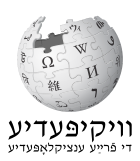Yiddish_Wikipedia
Yiddish Wikipedia
Yiddish-language Wikipedia
The Yiddish Wikipedia is the Yiddish-language version of Wikipedia.[1] It was founded on March 3, 2004,[2] and the first article was written November 28 of that year.
You can help expand this article with text translated from the corresponding article in Yiddish. (August 2011) Click [show] for important translation instructions.
|
